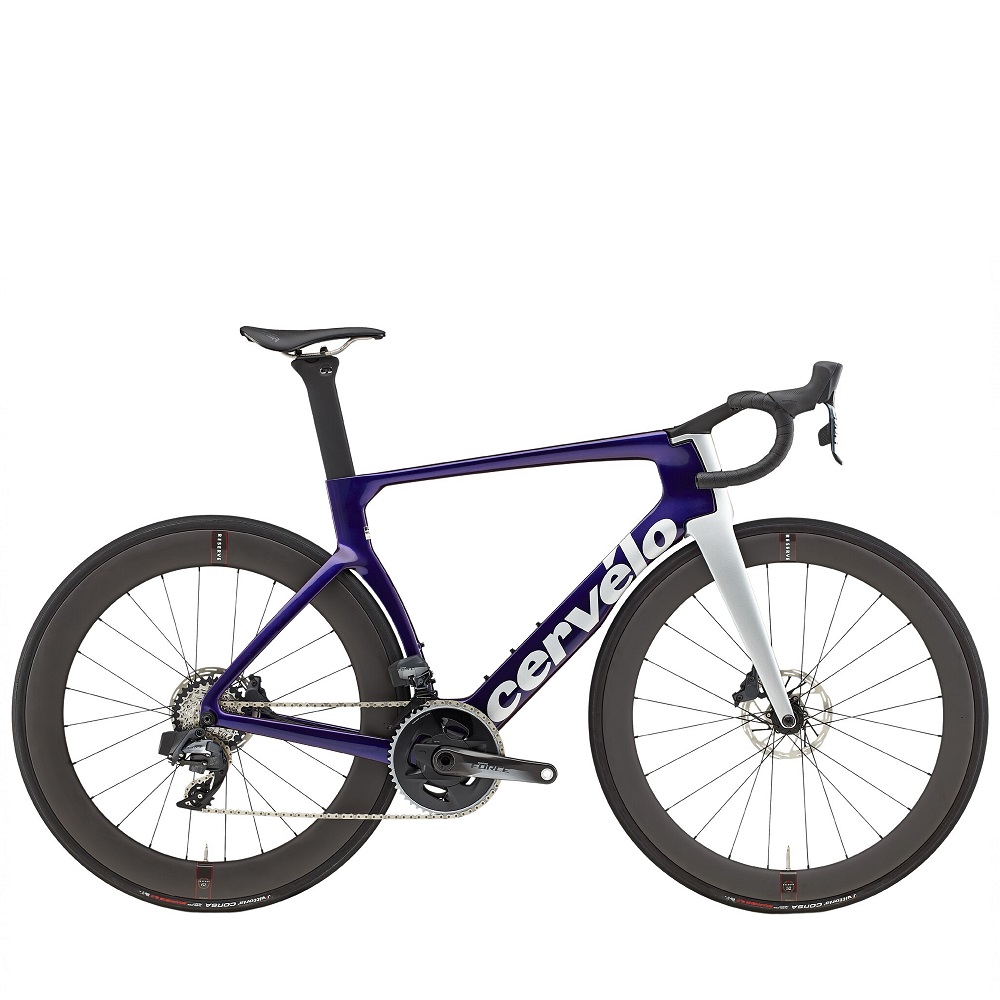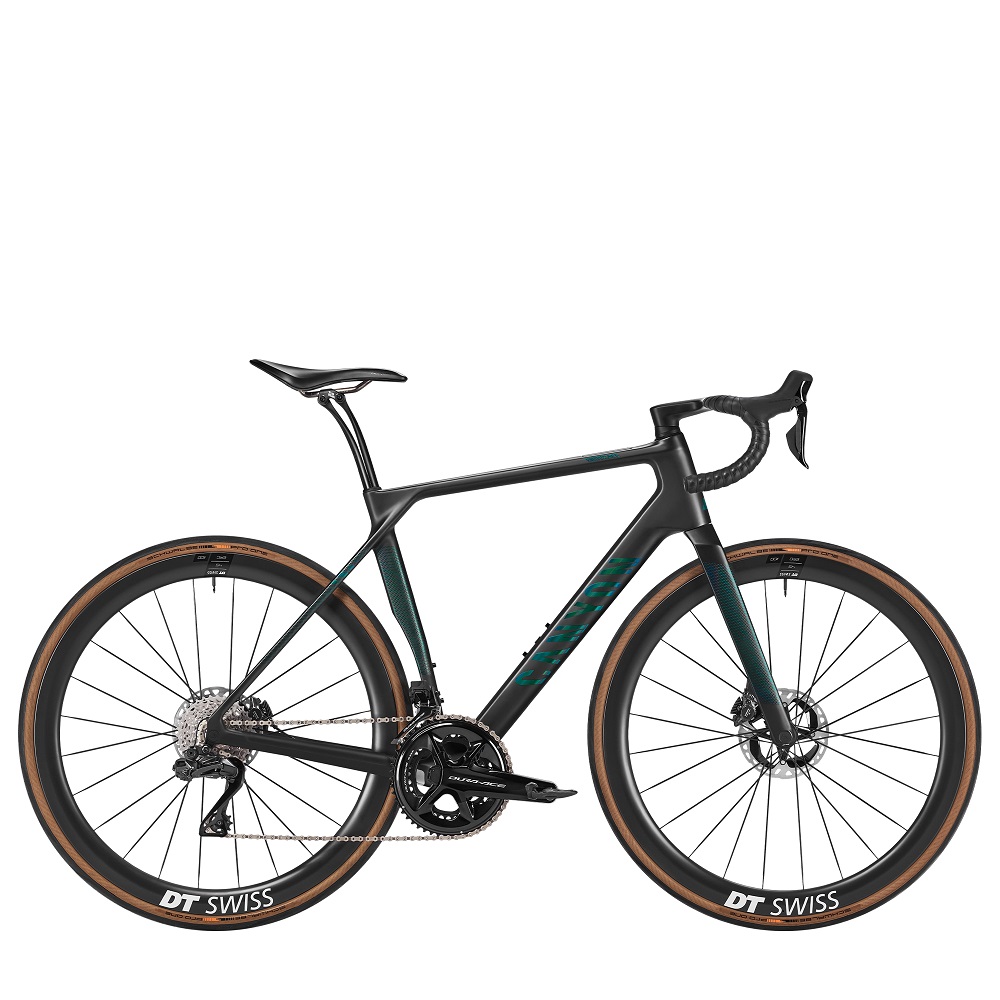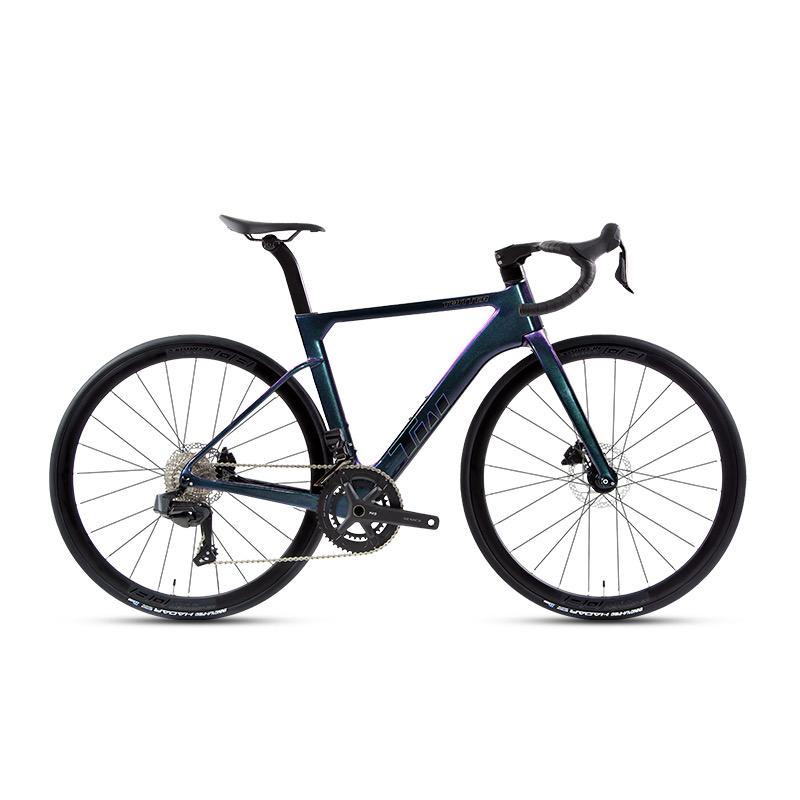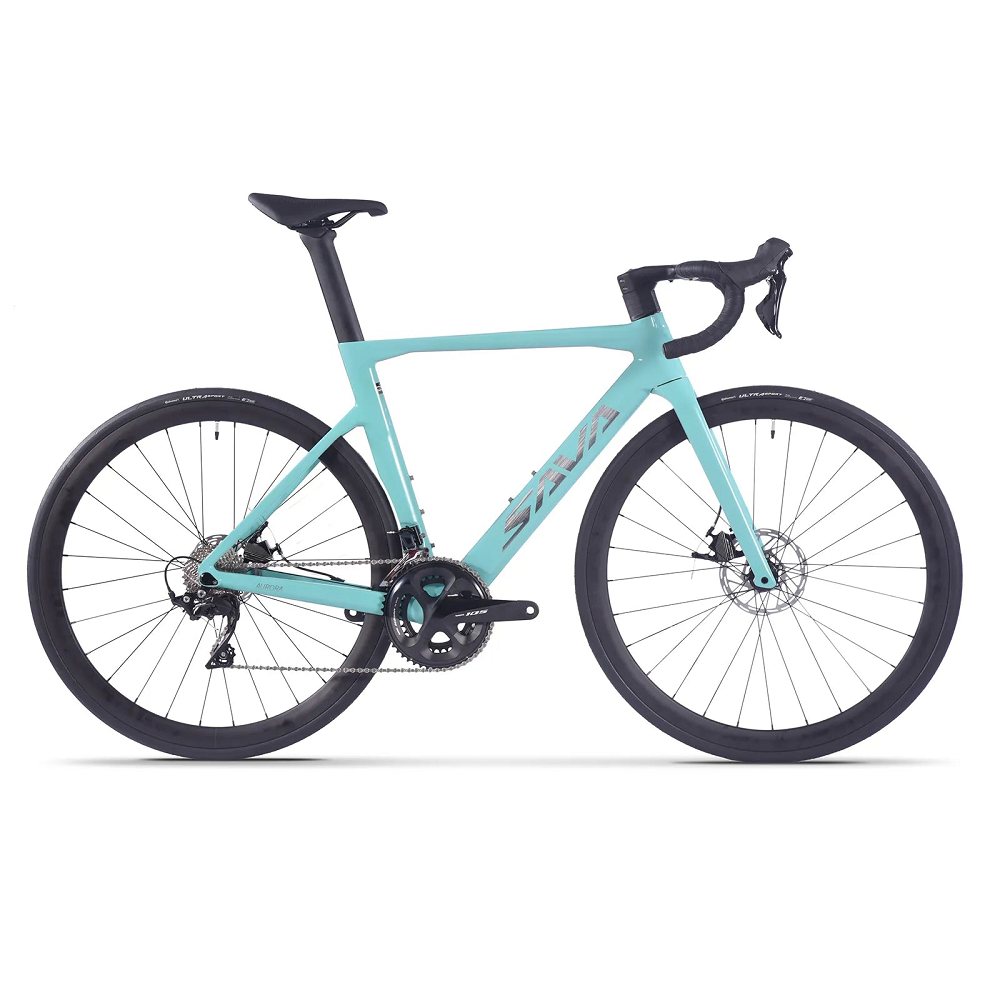What Makes Carbon Road Bikes Stand Out
Carbon road bikes have unique traits that set them apart from other bike types. Their advanced materials and innovative design deliver unmatched performance.
Key Features of Carbon Frames
Carbon frames are known for their exceptional strength and flexibility. These frames are made by layering carbon fibers, which ensures durability while staying lightweight. The frame’s stiffness improves power transfer, making each pedal stroke more efficient. Manufacturers can mold carbon into aerodynamic shapes for reduced drag and better speed.
Additionally, carbon frames allow custom tuning for specific riding styles. This makes the bike adaptable, whether for climbing hills or sprinting in races. The high-end finish also adds an attractive look to the bike.
Lightweight Construction: Why It Matters
Carbon road bikes are much lighter than bikes made from other materials like aluminum or steel. The lightweight construction reduces overall bike weight, making it easier to climb hills or accelerate quickly. This advantage is especially crucial for professional cyclists who need every second to count.
A lighter bike also reduces fatigue during long rides. Riders can maintain their energy for more challenging segments. This feature makes carbon road bikes ideal for endurance training and competitive racing.
![]()
The Advantages of Carbon Road Bike
Carbon road bikes provide several advantages that enhance the cycling experience. They combine lightweight design, advanced engineering, and unparalleled performance.
Enhanced Performance for Cyclists
Carbon frames are stiff, maximizing power transfer during pedaling. Each stroke propels riders effortlessly forward. This efficiency helps cyclists climb faster and accelerate more effectively.
Professional cyclists benefit from the responsiveness of carbon road bikes during races. The lightweight construction also improves endurance levels on long rides. Enhanced performance makes these bikes ideal for competitive racing and advanced training.
Vibration Damping for a Smooth Ride
Carbon fibers absorb road vibrations efficiently, ensuring a smoother ride. This reduces strain on muscles and joints during long-distance rides. Cyclists enjoy increased comfort and less fatigue, even on bumpy terrain.
The vibration damping enhances control, especially on uneven surfaces. It makes carbon road bikes suitable for recreational riders and professionals alike. These features build confidence during challenging rides.
Aerodynamic Advantages for Faster Speeds
Carbon frames can be molded into sleek shapes for improved aerodynamics. Reduced air resistance makes cyclists achieve higher speeds effortlessly. This design is particularly beneficial for time trials and flat terrains.
The aerodynamic advantage helps riders conserve energy during races and training. Cyclists experience less drag and smoother movement, outperforming competitors in various conditions. Carbon road bikes’ speed-focused design appeals to anyone aiming for peak cycling performance.

Comparing Carbon vs. Aluminum and Other Materials
When choosing a bike, frame material plays a crucial role. Carbon is a top-tier option, but aluminum and other materials also have their merits. Let’s examine the differences in weight, durability, cost, and usage to determine the right fit for your needs.
Weight and Durability Differences
Carbon road bikes are famously lightweight, often weighing much less than aluminum or steel options. This makes carbon frames ideal for climbing hills and accelerating quickly. The reduced weight also lowers rider fatigue during long rides.
Durability varies between materials. Carbon frames are strong but can be vulnerable to cracks under impact. Aluminum frames are sturdier for rough handling but are generally heavier. Steel, known for its toughness, is significantly heavier and less common in modern road bikes. Each material offers distinct trade-offs depending on your riding needs.
Cost-Effectiveness Analysis
Carbon road bikes are generally more expensive due to advanced materials and complex manufacturing. High costs may deter beginners or casual cyclists. Aluminum frames are more budget-friendly and provide excellent value for daily riding or training. Steel frames, though durable, are a heavier and less common choice in performance bikes. Evaluating your budget and performance goals helps with the decision.
Ideal Use Cases for Each Frame Material
Carbon: Best for competitive riders and those prioritizing speed, lightweight design, and aerodynamics. Perfect for racing, time trials, and endurance rides.
Aluminum: Suited for everyday riders, beginners, or those seeking a balance between performance and cost. Ideal for recreational rides and training.
Steel: Great for ultimate durability and comfort on long-distance touring. Best for riders who value toughness over weight.
Choosing the right frame material depends on your riding goals, budget, and personal preferences. Understand these differences to make an informed decision for your cycling experience.

Factors to Consider When Choosing a Carbon Road Bike
Choosing the right carbon road bike ensures a comfortable, efficient, and enjoyable riding experience. Several factors need careful evaluation to match your cycling needs and goals.
Frame Geometry and Fit
Frame geometry directly affects your riding comfort and bike handling. Look for a frame design that suits your riding style — whether it’s focused on racing, casual cruising, or endurance riding. Pay attention to elements like stack height and reach to ensure a proper fit. A well-fitted bike prevents injury and enhances performance over time.
It’s also important to match the bike size to your height and inseam measurements. Professional fitting services can help refine adjustments for optimal comfort. Riders who prioritize aerodynamics may prefer aggressive geometry, while endurance cyclists might opt for relaxed fits.
Component Groupsets: What to Look For
Components play a crucial role in a bike’s performance. Groupsets include the drivetrain, brakes, and gear mechanisms of the bike. When choosing a carbon road bike, find out if the groupset meets your performance needs.
Higher-end groupsets from Shimano, SRAM, or Campagnolo offer smoother shifting and lighter components, enhancing overall efficiency. For recreational riders, mid-range groupsets often provide great functionality without breaking the budget. Consider factors like gear ranges and weight to find the right balance.
Budget Considerations
Carbon road bikes come in a range of prices. Determine your budget based on your cycling goals and frequency of use. Entry-level models can be excellent for beginners, offering solid performance at a lower cost.
For competitive riders, investing in high-end models with advanced features might be worth it. Factor in additional costs for accessories like pedals, helmets, and maintenance tools. Always aim to balance quality and affordability to ensure long-term satisfaction with your bike choice.

Maintenance Tips for Carbon Road Bike
Proper maintenance keeps your carbon road bike performing at its best. Regular care ensures longevity and optimal functionality.
Cleaning and Care for Carbon Frames
Clean your carbon bike after every ride. Use a soft cloth and mild soap solution. Avoid abrasive sponges or harsh chemicals as they can damage the frame. Rinse gently with low-pressure water and dry completely.
Inspect the frame for dirt build-up, especially near joints and brackets. Lubricate the chain regularly to prevent wear and tear. If possible, store your bike indoors to protect it from moisture and extreme weather. Always use a bike stand to avoid unnecessary stress on the carbon frame.
Addressing Risks of Cracks and Damage
Carbon frames are strong but can crack under impact. Regularly check the frame for visible cracks or splits. Use a bright light to inspect hard-to-see areas like the bottom bracket and joints.
Avoid over-tightening bolts, which can stress the carbon material. Use a torque wrench to ensure proper pressure. Address minor scratches or chips immediately with touch-up kits to prevent further damage. In case of significant cracks, consult a professional for repairs.
Transport your carbon road bike carefully. Use padded racks to avoid accidental bumps. Proper care can extend your bike’s life and ensure maximum performance.

Popular Carbon Road Bike Models in 2023
If you’re considering a carbon road bike, 2023 offers a variety of great models. From leading brands to beginner-friendly options, here’s a breakdown to help you choose.
Top Brands Leading the Market
Some brands dominate the carbon road bike market with innovative designs and advanced technology.
- Specialized: Known for lightweight bikes with exceptional aerodynamics, Specialized excels in performance and comfort.
- Trek: Trek offers high-quality carbon bikes suitable for racing, training, and endurance rides.
- Cervélo: Their bikes focus on speed and efficiency, ideal for time trials and competitive racing.
- Giant: Giant provides dependable carbon road bikes, combining affordability with top-tier features.
- BMC: Designed for professionals, BMC bikes emphasize stiffness, aerodynamics, and cutting-edge materials.
These brands deliver unmatched quality, ensuring great options for all types of cyclists.
Best Value for Beginners
If you’re new to cycling, affordable carbon road bikes offer a good balance of quality and cost.
- Cannondale Synapse Carbon: Lightweight and versatile, it suits casual rides and endurance biking.
- Giant Contend SL Disc: This model is affordable yet loaded with performance features for smooth rides.
- Specialized Allez Sprint Comp: Great for intermediate riders, its durable frame excels in speed and comfort.
- Cube Attain GTC Pro: Offers a mix of comfort and performance for beginners stepping into carbon biking.
These models are perfect for starting your cycling journey without overspending.
Options for Professional Cyclists
For seasoned riders, professional-grade carbon bikes deliver peak performance and cutting-edge features.
- Cervélo R5: A lightweight bike with top aerodynamics, ideal for climbing and competitive racing.
- Trek ?monda SLR: Engineered for speed and agility, it’s perfect for experienced riders aiming for podiums.
- Specialized S-Works Tarmac SL7: Combines aerodynamics and versatility, fitting for multiple race types.
- Pinarello Dogma F: Known for stiffness and precision, it excels in aggressive race scenarios.
These options cater to cyclists focused on advanced training and professional racing goals.
Are Carbon Road Bikes Worth the Investment?
Carbon road bikes represent high-tech engineering and provide top performance for serious cyclists. They offer unique advantages that justify their cost for many riders. However, they also come with some trade-offs. Understanding these aspects is crucial before making a buying choice.
Long-Term Benefits for Cyclists
- Enhanced Performance: Carbon frames maximize power transfer, making every pedal stroke more efficient. Cyclists achieve faster speeds and better climbing capability with these bikes.
- Lightweight Build: Carbon road bikes are incredibly light, reducing rider fatigue on long or hilly rides. This weight advantage makes endurance training and competitive racing more manageable.
- Vibration Damping: The carbon material absorbs road vibrations, providing smoother, more comfortable rides. This is especially beneficial for long distances or uneven terrains.
- Aerodynamics: Carbon frames are designed with sleek shapes that minimize air resistance. Riders can conserve energy and maintain higher speeds in races or time trials.
- Customizable Design: Carbon offers flexibility for custom tuning. Riders can optimize their bike for specific performance needs, whether for sprinting or endurance cycling.
Trade-offs to Consider
- Higher Cost: Carbon road bikes are expensive due to advanced materials and manufacturing processes. This can deter beginners or budget-conscious riders.
- Durability Concerns: While strong, carbon frames are susceptible to cracks from hard impacts. Riders must be cautious and avoid rough handling.
- Maintenance Needs: Carbon bikes require regular care to prevent damage and maintain performance. Minor neglect can lead to costly repairs.
- Limited Suitability for Casual Riders: Recreational cyclists may find some features unnecessary, making aluminum or steel bikes more practical.
While carbon road bikes come with a higher price tag and specific needs, their advanced performance makes them worthy for dedicated riders. Weighing the trade-offs helps determine whether they align with your cycling goals and budget.
The Environmental Considerations of Carbon Bicycles
Sustainable Production Methods
When discussing the advantages of carbon road bikes, it’s essential to consider the environmental impact of their production. The production process for carbon fiber has traditionally been considered less eco-friendly than that of other materials, such as aluminum or steel. However, manufacturers are increasingly adopting more sustainable practices. Advances in recycling and manufacturing techniques aim to reduce waste and energy consumption associated with carbon fiber production.
Some companies are exploring the use of bio-based resins, which are derived from natural sources instead of petroleum, in conjunction with carbon fiber. This innovation has the potential to lower the carbon footprint associated with the manufacturing process. Additionally, the durability and longevity of carbon components mean that bicycles are less likely to require frequent replacements, reducing overall consumption and waste. For environmentally-conscious cyclists, choosing a carbon road bike from a company committed to sustainable practices can help align their passion for cycling with efforts to protect the planet.
The Carbon Lifecycle and Recycling Efforts
As carbon road bikes become more popular, discussions around the lifecycle of carbon materials are crucial. Once a carbon bike reaches the end of its life, it’s important to consider recycling options. Carbon fiber recycling is still in the early stages of development; however, companies are actively researching ways to repurpose carbon materials. Some methods involve shredding unused composites and using them in applications ranging from construction materials to new automotive parts.
By embracing recycling initiatives, cyclists can contribute to a more circular economy. Investing in brands that prioritize recycling and sustainable lifecycle management can help promote responsible consumption. As technology continues to evolve, the future of carbon road bikes may become even more aligned with environmental sustainability, giving cyclists a product that benefits both their performance and the planet.
The Future of Carbon Road Bikes
In conclusion, carbon road bikes represent a remarkable fusion of advanced engineering, performance benefits, and innovative design. Their lightweight nature, aerodynamic advantages, and exceptional ride quality make them the preferred choice for cyclists seeking to elevate their riding experience. As the cycling community grows, so does the emphasis on sustainability and responsible production methods.
With continued advancements in materials and recycling, the future of carbon road bikes appears bright. Cyclists can enjoy their rides knowing they are part of a movement that values both performance and environmental responsibility. Whether you are a competitive athlete or a casual rider, investing in a carbon road bike is a decision that promises unmatched performance today and the potential for sustainable practices in the future. By choosing wisely, cyclists can ensure their passion for biking aligns with a greater commitment to the health of our planet.
